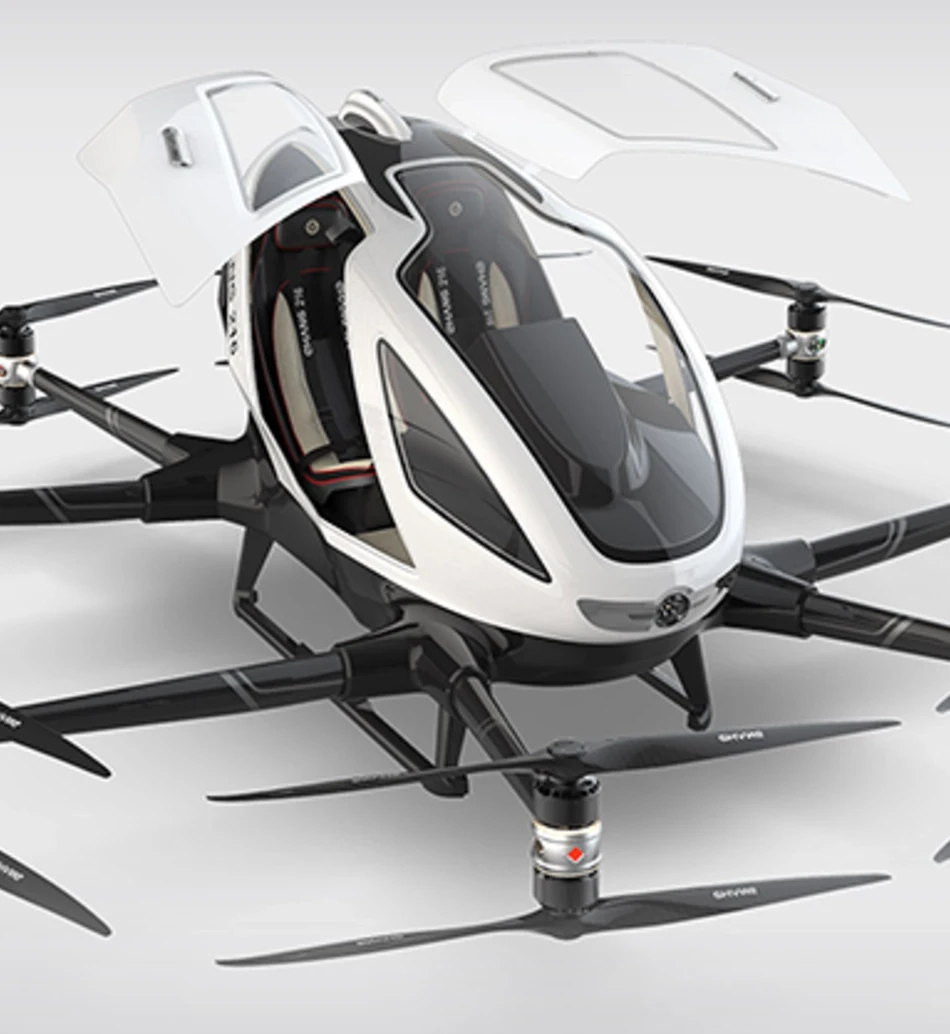All hail air taxis

Dozens of start-ups and companies have been in competition to launch their electric vertical take-off and landing (eVTOL) aircraft.
The challenge is to conquer the skies over megacities and provide short hops and commuting services on demand. Let’s take off for the immediate future with Volocopter, a pioneer of this new urban air mobility.
Bruce Willis flew one of them in “The Fifth Element”, the 1997 blockbuster film set in the 23rd century. Today, air taxis are about to take off in the real world, and without any special effects. Their most likely form? Drones, like those that have become commonplace in our skies in these last years, but large enough to carry passengers.
Categorised as non-helicopter electric vertical take-off and landing aircraft, or simply eVTOLs, the continued technological development of multirotors, batteries and stabiliser systems has contributed to their emergence.
Much quieter than current helicopters and producing zero emissions, this new class of aircraft seems to be a transport solution ideally suited for countering the exponential population growth in mega–cities and the increasingly saturated (highly polluting) traffic that
goes with it.
Taking an air taxi is a very appealing idea. But what will it cost?
The main players in the sector are optimistic and are targeting transport costs that are competitive with ground taxis. This means designing aircraft at reasonable production, operational and maintenance costs, which would be unprecedented in the world of air transportation.
Many other challenges remain to be tackled.
In order to be welcomed in urban skies at low-altitudes, the new aircraft should not be noisy – electric engines can be practically imperceptible from the ground. EVTOLs must be at least as safe as commercial aircraft and licensed by aviation authorities. Things are moving forward for this aspect as well. The European Union Aviation Safety Agency for instance has presented this summer its regulations on VTOLs, even covering autonomous navigation. Airspace will also have to be adapted to handle this new form of traffic – several cities are already working on it.
It is a beautiful dream, the technical challenges are fascinating and the market is promising. Consequently, a large number of players have entered the race. According to “Aviation Today”, over 150 companies have been developing flying taxi models and practically all major aviation players (Boeing, Airbus, Bell, Sikorsky, Embraer,
Rolls Royce, Nasa, Thalès…) have invested in designing models, infrastructures or components.
EVTOLs have their own dedicated newsletters, magazines and even international fairs. Dozens of start-ups are competing in innovation and fundraising.
The German company Volocopter (that we will cover in detail in this special feature) has been flying its prototypes since 2016. It has completed autonomous test flights in Dubai and is currently testing its services in Singapore. Kitty Hawk and Zee.Aero are supported by Larry Page, co-founder of Google. Jaunt Air Mobility has been working on its device which looks like a cross between a propeller plane and a helicopter.
The discrete Joby Aviation announced in early 2018 that they bene–fitted from an investment of 100 million dollars and completed a test flight. Since then, they have been apparently working in great secrecy on a new eVTOL equipped with tilt-rotors. In China, EHang has announced in early September that it had performed the first passenger carrying autonomous aerial vehicle (AAV) demonstration flight. There are many others as well.
And there is Uber.
The Silicon Valley giant has decided to add air transport to its conquest of urban transportation. In October 2016, it published “Uber Elevate”, a white paper presenting its vision for flying taxis (in the meantime, it launched a classic helicopter service last June). It organises an annual symposium, the most recent one having taken place in Washington in June.
Uber doesn’t want to be a manufacturer of eVTOLs, but rather a catalyst for aircraft development which could be used to provide its services. Unlike Volocopter, concentrating on inner-city traffic, Uber is targeting mega commuters with more powerful eVTOLs, capable of transporting at least 4 passengers (to increase profitability), at over 200kmph over a distance of 80km, return. They should be able to navigate autonomously (initially, a pilot would be on board).
These eVTOLs are being developed by its “vehicle partners”: Jaunt, Bell, EmbraerX, Pipistrel Vertical Solutions, Karem Aircraft and Boeing’s Aurora Flight Sciences. Uber is planning to use them as of 2023.
Which projects will never take off? Which start-ups will disappear? Which eVTOLs will remain as “sport and leisure” aircraft, reserved for the most exclusive rich clientele, subject to limited safety criteria? Which ones will actually be used by commercial air taxi services?
It is quite impossible to tell, but 2020 will be rich in news: with the 7th Annual Electric VTOL Symposium in California; the test flights by Volocopter and other companies; and the opening of Uber’s test vertiports in Los Angeles, Dallas and Melbourne.
The air taxi race has been launched. Skyport, the English start-up targeting the creation and operation of vertiports in cities, expects that 100,000 passenger drones will be operational by 2050. It is for the authorities and regulators to ensure that urban space mobility will not lead to additional traffic jams in the skies!





